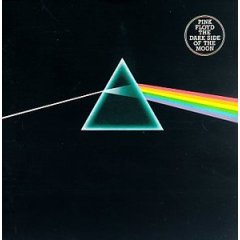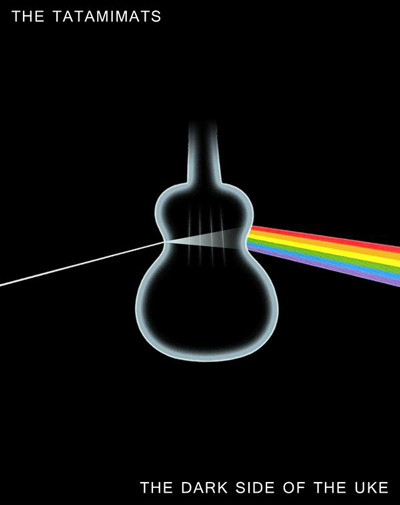The suite was developed during live performances, and was premiered several months before studio recording began. The new material was recorded in two sessions in 1972 and 1973 at Abbey Road Studios in London. The group used some of the most advanced recording techniques of the time, including multitrack recording and tape loops. Analogue synthesisers were given prominence in several tracks, and a series of recorded interviews with the band's road crew and others provided the philosophical quotations used throughout. Engineer Alan Parsons was directly responsible for some of the most notable sonic aspects of the album, and the recruitment of non-lexical performer Clare Torry. The album's iconic sleeve features a prism that represents the band's stage lighting, the record's lyrical themes, and keyboardist Richard Wright's request for a "simple and bold" design.
Following the release of Meddle in 1971, the band assembled for an upcoming tour of Britain, Japan, and the United States in December of that year. Rehearsing in Broadhurst Gardens in London, there was the looming prospect of a new album, although their priority at that time was the creation of new material. In a band meeting at drummer Nick Mason's home in Camden, bassist Roger Waters proposed that a new album could form part of the tour. Waters' idea was for an album that dealt with things that "make people mad", focusing on the pressures faced by the band during their arduous lifestyle, and dealing with the apparent mental problems suffered by former band member Syd Barrett. The band had explored a similar idea with 1969's The Man and The Journey. In an interview for Rolling Stone, guitarist David Gilmour said:
...I think we all thought—and Roger definitely thought—that a lot of the lyrics that we had been using were a little too indirect. There was definitely a feeling that the words were going to be very clear and specific.
Generally, all four members agreed that Waters' concept of an album unified by a single theme was a good idea. Waters, Gilmour, Mason and Wright participated in the writing and production of the new material, and Waters created the early demo tracks at his Islington home in a small recording studio he had built in his garden shed. Parts of the new album were taken from previously unused material; the opening line of "Breathe" came from an earlier work by Waters and Ron Geesin, written for the soundtrack of The Body, and the basic structure of "Us and Them" was taken from a piece originally composed by Wright for the film Zabriskie Point. The band rehearsed at a warehouse in London owned by The Rolling Stones, and then at the Rainbow Theatre. They also purchased extra equipment, which included new speakers, a PA system, a 28-track mixing desk with four quadraphonic outputs, and a custom-built lighting rig. Nine tonnes of kit was transported in three lorries; this would be the first time the band had taken an entire album on tour, but it would allow them to refine and improve the new material, which by then had been given the provisional title of Dark Side of the Moon (an allusion to lunacy, rather than astronomy). However, after discovering that that title had already been used by another band, Medicine Head, it was temporarily changed to Eclipse. The new material premièred at The Dome in Brighton, on 20 January 1972, and after the commercial failure of Medicine Head's album the title was changed back to the band's original preference.[nb 1]
Dark Side of the Moon: A Piece for Assorted Lunatics, as it was then known, was performed in the presence of an assembled press on 17 February 1972—more than a year before its release—at the Rainbow Theatre, and was critically acclaimed. Michael Wale of The Times described the piece as "... bringing tears to the eyes. It was so completely understanding and musically questioning." Derek Jewell of The Sunday Times wrote "The ambition of the Floyd's artistic intention is now vast." Melody Maker was, however, less enthusiastic: "Musically, there were some great ideas, but the sound effects often left me wondering if I was in a bird-cage at London zoo." The following tour was praised by the public. The new material was performed live, in the same order in which it would eventually be recorded, but obvious differences between the live version, and the recorded version released a year later, included the lack of synthesisers in tracks such as "On the Run", and Bible readings that were later replaced by Clare Torry's non-lexical vocables on "The Great Gig in the Sky".
The band's lengthy tour through Europe and North America gave them the opportunity to make continual improvements to the scale and quality of their performances. Studio sessions were scheduled between tour dates; rehearsals began in England on 20 January 1972, but in late February the band travelled to France and recorded music for French director Barbet Schroeder's film, La Vallée.[nb 2] They then performed in Japan and returned to France in March to complete work on the film. After a series of dates in North America, the band flew to London to begin recording the album, from 24 May to 25 June. More concerts in Europe and North America followed before the band returned on 9 January 1973 to complete work on the album.
The Dark Side of the Moon built upon experiments Pink Floyd had attempted in their previous live shows and recordings, but lacks the extended instrumental excursions which, according to critic David Fricke, had become characteristic of the band after founding member Syd Barrett left in 1968. Guitarist David Gilmour, Barrett's replacement, later referred to those instrumentals as "that psychedelic noodling stuff", and with Waters cited 1971's Meddle as a turning-point towards what would be realised on the album. The Dark Side of the Moon's lyrical themes include conflict, greed, the passage of time, death, and insanity, the latter inspired in part by Barrett's deteriorating mental state; he had been the band's principal composer and lyricist. The album is notable for its use of musique concrète and conceptual, philosophical lyrics, as found in much of the band's other work. Each side of the album is a continuous piece of music. The five tracks on each side reflect various stages of human life, beginning and ending with a heartbeat, exploring the nature of the human experience, and (according to Waters) "empathy". "Speak to Me" and "Breathe" together stress the mundane and futile elements of life that accompany the ever-present threat of madness, and the importance of living one's own life—"Don't be afraid to care". By shifting the scene to an airport, the synthesiser-driven instrumental "On the Run" evokes the stress and anxiety of modern travel, in particular Wright's fear of flying. "Time" examines the manner in which its passage can control one's life and offers a stark warning to those who remain focussed on mundane aspects; it is followed by a retreat into solitude and withdrawal in "Breathe (Reprise)". The first side of the album ends with Wright and vocalist Clare Torry's soulful metaphor for death, "The Great Gig in the Sky". Opening with the sound of cash registers and loose change, the first track on side two, "Money", mocks greed and consumerism using tongue-in-cheek lyrics and cash-related sound effects (ironically, "Money" has been the most commercially successful track from the album, with several cover versions produced by other bands). "Us and Them" addresses the isolation of the depressed with the symbolism of conflict and the use of simple dichotomies to describe personal relationships. "Brain Damage" looks at a mental illness resulting from the elevation of fame and success above the needs of the self; in particular, the line "and if the band you're in starts playing different tunes" reflects the mental breakdown of former band-mate Syd Barrett. The album ends with "Eclipse", which espouses the concepts of alterity and unity, while forcing the listener to recognise the common traits shared by humanity. The album was recorded at Abbey Road Studios, in two sessions, between May 1972 and January 1973. The band were assigned staff engineer Alan Parsons, who had worked as assistant tape operator on Atom Heart Mother, and who had also gained experience as a recording engineer on The Beatles' Abbey Road and Let It Be. The recording sessions made use of some of the most advanced studio techniques of the time; the studio was capable of 16-track mixes, which offered a greater degree of flexibility than the eight- or four-track mixes they had previously used, although the band often used so many tracks that to make more space available second-generation copies were made.
Following the release of Meddle in 1971, the band assembled for an upcoming tour of Britain, Japan, and the United States in December of that year. Rehearsing in Broadhurst Gardens in London, there was the looming prospect of a new album, although their priority at that time was the creation of new material. In a band meeting at drummer Nick Mason's home in Camden, bassist Roger Waters proposed that a new album could form part of the tour. Waters' idea was for an album that dealt with things that "make people mad", focusing on the pressures faced by the band during their arduous lifestyle, and dealing with the apparent mental problems suffered by former band member Syd Barrett. The band had explored a similar idea with 1969's The Man and The Journey. In an interview for Rolling Stone, guitarist David Gilmour said:
...I think we all thought—and Roger definitely thought—that a lot of the lyrics that we had been using were a little too indirect. There was definitely a feeling that the words were going to be very clear and specific.
Pink Floyd Dark Side Of The |  Pink Floyd - Dark Side of |  DARK SIDE OF THE MOON CD |  Pink Floyd: Dark Side Of The |  pink floyd dark side of the |
 Dark Side of the Moon: |  Pink Floyd Dark Side Of The |  Pink Floyd\x26#39;s two Merriweather |  Pink Floyd: Dark Side of the |  pink floyd dark side of the |
The band's lengthy tour through Europe and North America gave them the opportunity to make continual improvements to the scale and quality of their performances. Studio sessions were scheduled between tour dates; rehearsals began in England on 20 January 1972, but in late February the band travelled to France and recorded music for French director Barbet Schroeder's film, La Vallée.[nb 2] They then performed in Japan and returned to France in March to complete work on the film. After a series of dates in North America, the band flew to London to begin recording the album, from 24 May to 25 June. More concerts in Europe and North America followed before the band returned on 9 January 1973 to complete work on the album.
 [The Dark Side Of The Moon] |  Dark Side of the Uke |  Pink Floyd albums: Dark |  Pink Floyd - Dark Side |  Pink Floyd Dark Side of the |
 Pink Floyd\x26#39;s Dark Side Of |  Pink Floyd - Dark Side of The |  Pink Floyd - Dark Side Of The |  Pink Floyd\x26#39;s Dark Side Of The |  Pink Floyd - Dark Side of the |
No comments:
Post a Comment